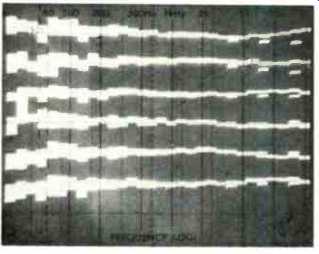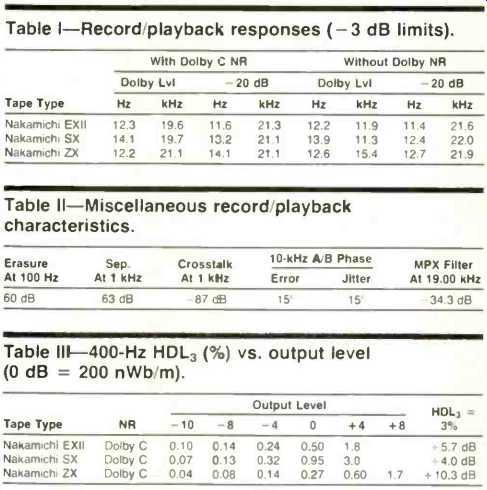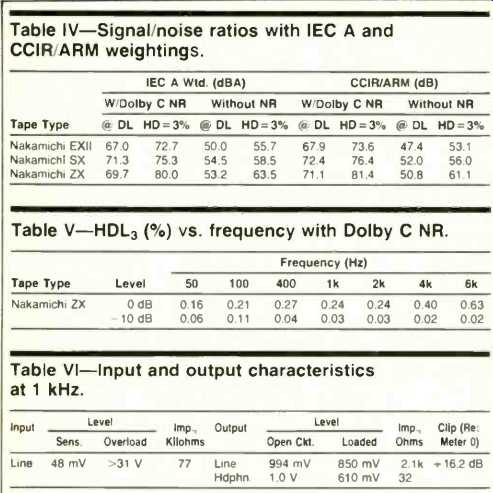
Manufacturer's Specifications:
Frequency Response: 20 Hz to 20 kHz, ±3 dB.
Harmonic Distortion: Less than 0.9% at 200 nWb/m.
Signal/Noise Ratio: 64 dBA; 70 dBA with Dolby C NR.
Separation: 36 dB.
Crosstalk: -60 dB.
Erasure: 60 dB at 100 Hz.
Input Sensitivity: 50 mV.
Output Level: Line, 1.0 V at 2.2 kilohms; headphone, 5 mW at 8 ohms.
Wow and Flutter: 0.027% wtd. rms, ± 0.048% wtd. peak.
Fast-Wind Time: 80 S for C-60
Dimensions: 16-15/16 in. (430 mm) W x 3-15/16 in. (100 mm) H x 9 1/8 in. (250 mm) D.
Weight: 12.3 lbs. (5.6 kg).
Price: $650.00.
Company Address: 19701 S. Vermont Ave., Torrance, Cal. 90502.
The BX-300 is the latest addition to Nakamichi's BX series of lower-priced cassette decks. It has several features designed to attract the serious recordist: Three discrete heads; 50-dB, peak-responding meters; Dolby B and C NR; "diffused-resonance" dual-capstan drive, and a dual speed, electronic fader.
Having three heads, of course, enables off-tape monitoring while recording, and allows the head designs to be optimized for their individual functions. Wide-range, peak responding meters are really needed to cope with' the improved dynamics of such new sources as Compact Discs.
Dolby C noise reduction also does a better job of preserving the dynamic range of the source material than does Dolby B NR. Improved transport design brings greater clarity, with lower flutter and modulation noise. And the electronic "Master Fader" of the BX-300 solves the problem of getting both channels of a stereo level control to track each other closely, while its two speeds provide added flexibility in making smooth fades.
Gold designations give the BX-300's black front panel a subdued attractiveness, but require normal to fairly bright room light for easy reading. At the very left are the "Power" switch, "Timer Rec/Play" switch, "Pitch Control" and headphone jack. The "Pitch Control" pot is center-detented, and has a range specified as ±6% of normal speed. The control is effective in playback only; this prevents off-speed recording, both by accident and on those vary rare occasions when it might be desired.
Just to the right are four large, horizontal rocker bars for the main operating functions. From top to bottom, these are: "Rewind/Fast-Forward," "Stop/Play," "Pause/Rec" and "Master Fader" ("Up/Down"). All but the fast-wind bar have LED status indicators-red for recording, green for the rest.
The switching logic permits instant switching from any mode into stop, play or fast-wind modes, but not into recording. Pushing "Rec" puts the deck in record-standby mode, with the transport paused and record-level indicators working; recording only starts when you push "Play" thereafter. Holding in the "Rec" control during recording mutes the signal till the control is released.
The two "Master Fader" speeds are controlled by pressure on the rocker bar. A light tap starts a 4-S fade, while holding the bar in quickens the fade to 2-S. The status lights not only indicate the direction of fade but change brightness as the fade progresses to show what is happening. This control operates only during recording, and all fades are between full off and the limits set by the manual slide pots; there's no way to stop the control halfway. The "Master Fader" performs very well, and most users would probably use it regularly.
The line of controls just to the right of the rocker bars starts with a soft-touch "Eject" control. Below that are the LED-type, four-digit counter ("999" to "9999") and its associated three controls, the "Reset" button and on-off switches for "Memory Stop" and "Auto Repeat." The BX-300's counter memory has two useful and unusual features: Fast-winding will stop at "0000" from either direction or will keep going past that point if the fast-wind button is held in, with no need to switch the memory off. The "Auto Repeat" function rewinds the tape back to its beginning (if the memory switch is off) or back to "0000" (if memory is switched on), replays the tape to its end, then repeats the cycle indefinitely until switched off.
With the cassette compartment door open, access for all tasks is very good; with the door/cover slid off, cleaning is a snap. The three-head configuration and the dual-capstan drive appeared rigid and well constructed. The BX-300 is also typical Nakamichi in offering ready access to the head adjustments when the cover is off. In my view, this makes an important contribution to getting and keeping maximum performance from a deck.
To the right of the cassette compartment are the vertical, LED-ladder level meters and the vertical-slider output- and input-level controls. The level meters cover the range from -40 to +10 dB relative to Dolby level and are peak responding, both desirable features. Each channel ladder has 10 double-bar segments, with the best resolution (3 dB) between "+4" and "+ 10"; this seemed too coarse at first, but judgment was reserved for the results during the listening tests. The long vertical travel of the input and output level sliders provides good resolution for easy level setting.
The side-by-side positioning and the medium friction of the left and right sliders made adjustments very easy, whether for two-channel or interchannel level changes.
Just to the right are the switches associated with noise reduction: "Dolby NR" ("Off/On" and "B/C") and the multiplex filter. Indicators above the level meters remind the recordist which NR (if any) has been selected. At the bottom is the center-detented "Bias Tune" control, which greatly expands the number of tapes that will give optimum performance with the deck, particularly when Dolby NR is used.
At the very right, starting from the top, are the "Monitor" switch ("Tape/Source"), the "EQ" switch ("120/70") and the interlocked tape-selector buttons for "EX(I)," "SX(II)" and "ZX(IV)." Nakamichi continues to use their own tape-formulation designations for switch labels, but they have now added the IEC Tape Type numbers, which ought to minimize confusion.
The rear panel has line-level input/output phono-jack pairs (as with many modern decks, there are no microphone inputs) and a socket for the optional remote control. A look inside showed that most of the circuitry is on one large, horizontal p.c. board. The card is fairly well supported, but is a bit springy in spots. There are also a few small, vertical cards; the one for the power supply had two pigtail fuses.
Most of the interconnections were made with multi-conductor cabling. The parts appeared to be of good quality, and all of them were identified by part number. The transport was quiet in operation, and I judged it to be of good construction. The box-chassis configuration made for considerable rigidity, even more so with the removed cover back in place.
Measurements
With the exception of some fringing-response boost at the lowest frequency and a little peak at the highest frequency, the playback frequency responses for both equalizations were within ± 1.7 dB. Tape play speed was very slightly high, about 0.1% fast. Playback levels seemed to be indicated correctly, as near as one could tell from the limited resolution of the level meters.
With the use of a pink-noise source and a 1/3-octave RTA monitor, the record/playback responses were checked both with and without Dolby C NR for approximately 50 formulations. The "Bias Tune" control was used to get the best responses, which resulted in the best Dolby NR tracking.
The results were excellent with many tapes: BASF Pro I Super, Denon DX4, Fuji FR-I, Konica GMI, Maxell UD-XL I, PD Magnetics Tri-Oxide Ferro HG and TDK AD for the Type Is, and BASF Pro II Chrome, JVC DA1, Maxell UD-XL II and XL II-S, PD Magnetics 500 Crolyn HG, Scotch XSII, Sony UCX, TDK SA, SA-X and HX-S, and Yamaha CR for Type IIs.
(The deck did not have quite enough bias to match Yamaha CR-X.) With the Type IV metal tapes, the best matches came with Fuji FR Metal, Maxell MX, Memorex Metal IV, PD 1100 Metal, Realistic Supertape Metal, Sony Metallic, TDK MA and Yamaha MR. (The minimum bias setting in the Type IV position was too high for metal tapes from BASF, Denon, Konica, Loran and Magnex.) The BX-300 showed the best Dolby C NR tracking among a large number of tapes for any deck tested to date.
All of the following detailed tests utilized the three Nakamichi formulations supplied with the unit. Because of the results of some previous special tests on Dolby C NR tracking, I made all record/playback responses with pink noise, limited to a band from 15 Hz to 27 kHz. Responses made with a swept sinusoid show "errors" that do not exist with music or music-like signals. Figure 1 shows the record/ playback responses for the three formulations, with and without Dolby C NR, both at Dolby level and 20 dB below that. All of the responses are very flat, and the Dolby C NR tracking is excellent in all cases. Take note of the fact that the responses are more extended at 0 dB with Dolby C than without. Table I lists the-3 dB limit points found with a sine wave test signal. They are all excellent, reflecting the flatness shown in Fig. 1.

Fig. 1--Record/playback responses with (solid trace) and without (dashed
trace) Dolby C NR. From top to bottom: Nakamichi EXII (Type I) tape at Dolby
level, Nakamichi SX (Type II) tape at Dolby level, Nakamichi ZX (Type IV)
tape at Dolby level, EXII at -20 dB, SX at-20 dB, and ZX at-20 dB. (Vertical
scale: 5 dB/div.)

Table I--Record/playback responses (-3 dB limits).
Table II--Miscellaneous record/playback characteristics.
Table III--400-Hz HDL3 (%) vs. output level (0 dB = 200 nWb/m).

Table IV-Signal/noise ratios with IEC A and CCIR/ARM weightings.
Table V--HDL3 (%) vs. frequency with Dolby C NR.
Table VI--Input and output characteristics at 1 kHz.
Table II lists the results from several record/playback tests, and these figures are all excellent, too. The phase and jitter figures are among the best I have ever measured, and the multiplex notch was exactly at 19.00 kHz. The bias in the output during recording was very low, bettered by very few decks. "Bias Tune" varied level at 10 kHz from +3.5 dB (minimum bias) to 1.7 dB (maximum bias) relative to flat response with SX (Type II) tape.
Third-harmonic distortion (HDL3) was measured for all three tapes from 10 dB below Dolby level to the point where the 3% distortion limit was reached ( Table Ill). I call attention to the fact that the levels listed are the output levels. In the past, I had used record levels, as the recordist would see them in "Source." Because of compression at the higher recording levels, however, the output levels-as would be seen in "Tape"-are slightly lower, perhaps a dB or more at the 3% limit. The figures for SX are fairly good, those for EXII are better at the higher levels, and the performance with ZX is really excellent over the entire level range.
The signal-to-noise ratios for the three tapes, with and without Dolby C NR and with both IEC A and CCIR/ARM weightings, appear in Table IV. The results are consistently impressive, including those for the Type I tape. The metal tape, ZX, really shines here and in Table Ill, demonstrating that the BX-300 cassette deck takes full advantage of metal tape's superiority.
Further evidence along these lines Is shown in Table V, which presents distortion versus frequency. The distortion figures are fairly low across the band, even at 0 dB. At 10 dB, distortion was difficult to measure at a number of points because it was so low -0.03% or less, which is 80 dB or more below the 200 nWb/m reference level.
Table VI lists various input and output characteristics measured at 1 kHz. The line-input impedance of 77 kilohms was measured with the slider two-thirds up. With the slider all the way up, the impedance dropped to 24 kilohms, still plenty high enough. The load for the headphone tests was 50 ohms; with the load at 8 ohms the output was 5 mW, matching Nakamichi's specification. Just holding the two channel knobs together, I was able to make a fade down from maximum for over 65 dB before the channel levels differed by more than 1 dB. The two sections of the output level slider stayed within 1 dB for more than 80 dB down from maximum-certainly the best that I can remember. The output polarity was the same as the input in "Tape," but it was reversed in "Source." "Master Fader" times were 2S and 4S, as specified.
Tests on the LED-ladder meters gave imprecise results because of the poor resolution of the steps, and readings of "-9" (?), "-5," "0," "+4," "+7" and "+10" seemed too far apart in this important level region. The "-40" double segments were always illuminated, and the first turn-on for "-30" was actually at about-27 dB, relative to zero turn on. The other thresholds corresponded more closely to the scale markings, and the highest ones were very accurate.
The meters'-3 dB points could not be read directly, but they were at about 22 Hz and 20 kHz. The response time of the meters was plenty short enough to meet peak-meter requirements, and the 1.6-S decay time was also to standard. The meters showed true peak detection with a test tone burst given a negative d.c. offset, but did not do so with a positive offset.
Using the supplied Nakamichi test tape, I measured flutter in playback to be 0.022% weighted rms and ± 0.035% weighted peak. In record/playback, the flutter was 0.028% weighted rms and ± 0.043% weighted peak with some cassettes, but slightly above specification at 0.035% weighted rms and ± 0.055% weighted peak with others, extremely good in any case. I detected no change in play speed (less than 0.01%) with line voltage anywhere from 110 to 130 V. Momentary speed variations were less than ± 0.01%. The fast-wind times for a C-60 cassette averaged 64 S, typical for many decks and much less than the 80 S specified. The pitch control, effective in play mode only, could set speed anywhere from 6.6% to + 7.3% of normal ape speed, providing just a little more than a semitone 5.9%) in each direction. All changes in mode, including un-out to "Stop," required 1 S or less. Loose-loop take-up was actuated with each closing of the cassette compartment door.
Use and Listening Tests
The owner's manual is basic and straightforward, rather undetailed, but there are good comments on setting bias and cleaning. The pushbutton switch action felt good, but at east medium-level lighting was needed to be certain of which selection had been made. I liked the rocker-bar transport switches, but I did feel a little frustrated, on occasion, when I couldn't punch in "Rec" from play or pause mode. Holding in "Rec" for record-mute was certainly easy, and it seemed natural after a couple of times.
I had some doubts about the ease of setting levels because of the low resolution of the meters, but the nature of music, and the way the meter segments' intensity varied with the dynamics of the performance, fairly well obscured he indication-level jumps. Peak holding would have been nice, but there was really nothing to fault in the meter dynamics.
Listening tests were run primarily with pink noise for NR racking checks and with dbx-encoded records from Sine Qua Non and Chalfont. As expected, the tracking was excellent over a wide range of levels. In setting levels for recording from records, I spent some time listening at very high levels-far above normal-to see where I would set maximum levels on the basis of a heard-distortion limit. I concluded that, for my ears, I had to keep even the shortest peaks from reaching the indications associated with the 3% limits measured earlier. All three tape types provided excellent sound, although the high-level limit was most obvious with SX. I thought the piano sound to be excellent in playback. In a recording of Ravel's "Bolero" (Morton Gould and he London Symphony Orchestra, Chalfont SDG301), there was a very slight loss in the impact of the tympani near the end of the piece, out this was only with the recording level on the high side and the listening level even more so.
The BX-300 is a very worthwhile addition to Nakamichi's BX series. Aside from a few special features, such as the "Master Fader," it does not have a collection of microprocessor-controlled conveniences for its medium-high price. Instead, it offers a number of things that the serious recordist will find more important: Outstanding record/playback responses with Dolby C NR with a number of different apes, very low distortion (especially with metal tape), the highest signal-to-noise ratio (80.0 dBA) measured to date with Dolby C NR, and very low flutter. Mention should be made of the pitch control, the bias trimmer, the excellent level sliders and the wide-range peak-responding meters quite good in practice, despite my criticisms. In its general price range, the BX-300 is unequalled when performance is he criterion. On this basis, it is worthy of comparison with any other deck at any price.
-Howard A. Roberson
(Source: Audio magazine, Nov. 1984 )
Also see:
Nakamichi 1000ZXL Limited Cassette Deck (Sept. 1982)
Nakamichi cassette decks (Dec. 1982)
Nakamichi Model 600 Stereo Cassette Console (Sept. 1976)
Nakamichi CR-4A Cassette Deck (Aug. 1988)
= = = =